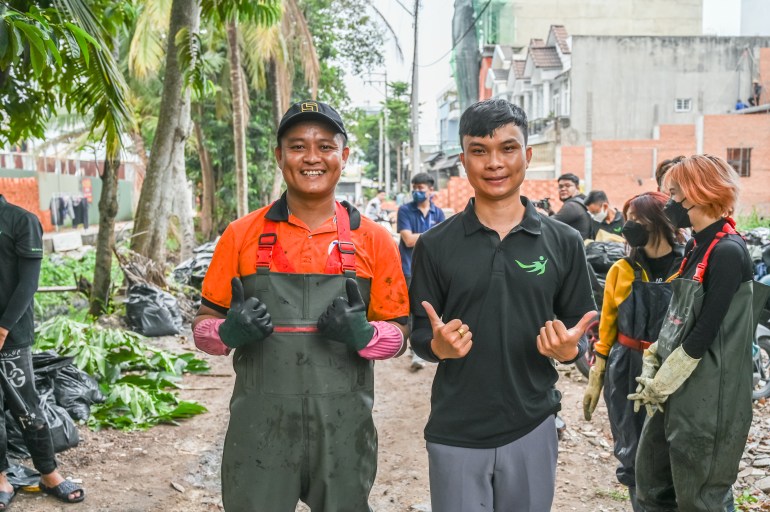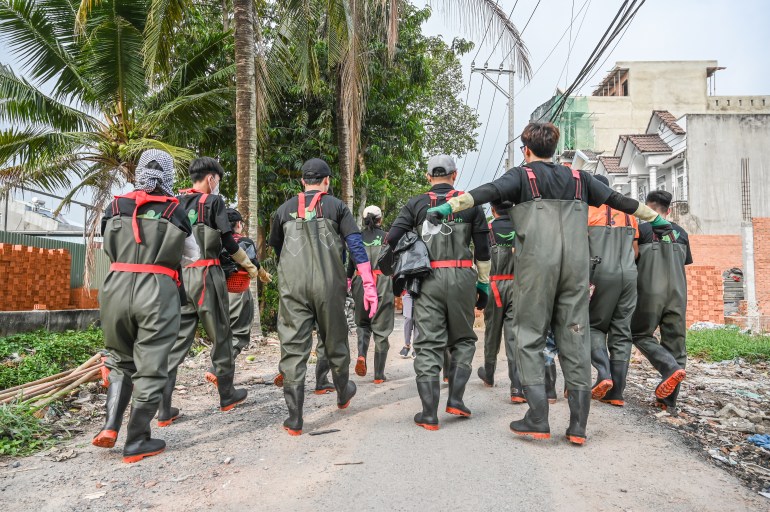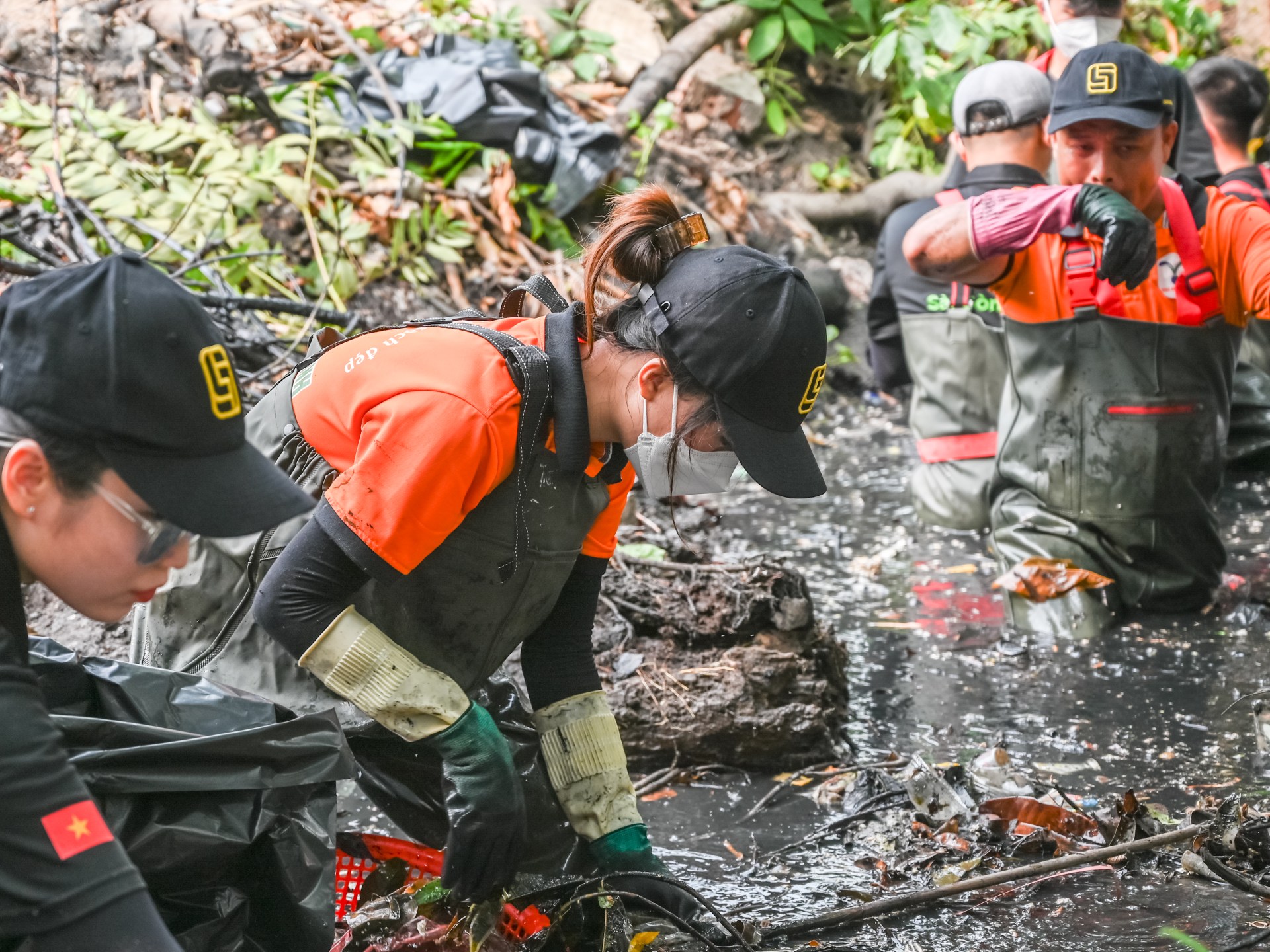‘Meaningful work’: Volunteers clean Ho Chi Minh City’s fetid canals by hand | Environment News
Ho Chi Minh City, Vietnam – It is barely 7am when Nguyen Luong Ngoc and his team of young volunteers meet in the depths of District 12 in Ho Chi Minh City.
A vast pile of takeaway breakfast boxes waits on one side of the narrow road. Behind them lies a stinking canal stuffed with rubbish; its water black and barely moving.
As each volunteer arrives and grabs a box of food, the mood lifts. Everyone is smiling, cracking jokes despite the smell and the mess.
Eventually, a truck pulls up carrying a load of waterproof dungarees and other equipment. The team get into the green rubber suits, spray themselves with mosquito repellent, put on long gloves and wade into the water.
Ngoc and the other volunteers at Sai Gon Xanh – which translates to ‘Green Saigon’ – run regular sessions like these; cleaning up waterways around Vietnam’s biggest city by hand, pulling the rubbish from the water and leaving it in bin bags for waste collectors to remove.
Nhu Van Hoa joined the team a few months ago and is now a regular. Having picked his way through water thick with putrid, rotting food waste, he holds up his glove-covered hands, drenched in black filth.
“I use three layers of gloves,” he said.
The work might be risky, smelly and unpleasant, but there are now hundreds of people like Hoa who join the gatherings in the hope that they can inspire change among the more than 10 million residents of Ho Chi Minh City, once known as Saigon.
The cleanups take place between three and five times a week, and on the weekend, the group tries to rope in as many people as possible.
“On Sundays, that’s when we call everyone – as many volunteers as we can get – roughly about 100 to 200 people, to do the cleanup,” Ngoc told Al Jazeera.

Most of the volunteers are university students, restaurant staff or motorbike taxi drivers, and have irregular schedules, so Sai Gon Xanh creates a flexible timetable to give them all the opportunity to participate.
Another volunteer, Hoang Thi Thanh Nga, is just 20 years old. She joined the Sai Gon Xanh team because she wanted to contribute to her city.
She says the water is not cold at this time of the year, and volunteers get used to the smell.
The length of time spent cleaning up depends on the location. “In some places, one session is enough which is around three to four hours,” said Ngoc. “Sometimes it’s a whole day or two, three days, it depends on the site.”
No official recycling system
Ho Chi Minh City produces about 9,500 tonnes of domestic rubbish every day and there is little in the way of formal recycling.
The city’s two main landfills are rapidly reaching capacity and authorities are looking to incineration and the conversion of waste into energy as potential ways forward.
“Despite being the commercial capital of the country, there is no official urban waste recycling system in Ho Chi Minh City,” Bijeesh Kozhikkodan Veettil, an expert in remote sensing, GIS and environmental research at the city’s Van Lang University, told Al Jazeera. “Instead, the local government depends on small companies for waste management in the city.”
The Sai Gon Xanh team usually chooses a ward to clean up and then contacts the local government representatives to seek their permission. They also ask for advice on which locations are most in need of their help.

The cleanups typically take place in the mornings when the sun is not too strong and the air is still comparatively cool. The team gathers, and the suits – provided by Sai Gon Xanh – are distributed.
But while the suits look impressive, they go only a small way to protecting the volunteers from the dangers of their work.
“The rubber suit is what we bought at the small factory store,” said Ngoc. “They are normal rubber … and just [make the work] a little bit less dangerous.”
The volunteers face serious health risks from the rank waterways.
“If you’re negligent, you could die,” said Ngoc. “It causes a lot of skin problems … intestine problems, lung problems, so it does affect a lot with regards to health.”
There is also the risk of stepping on a needle while working in the rivers, he said. The team all take regular anti-HIV medication to lower the risk of infection.
“This helps prevent roughly up to 70 – 80 percent [of HIV infections],” said Ngoc, adding that the volunteers also stay up to date with vaccinations for as many other diseases as possible.
A mindset shift
But for the Sai Gon Xanh volunteers, the risk is worth it.
“Every time we have finished cleaning up the canals, I feel very happy,” Hoa told Al Jazeera.

According to Hoa, many people in Ho Chi Minh City have little awareness of the consequences of littering.
A lot of this comes down to a culture of convenience, according to Ngoc.
“[There are] a lot of hawkers, street food vendors, and they use a lot of these one-time-use products, like plastic bags [and] utensils,” he said. “There are not a lot of garbage bins around the city, so that’s why there’s a habit of people just throwing it as is convenient for them.”
This is particularly true of the migrants who come to the city from other parts of the country and do not stay long enough to see the effect of persistent littering, he added.
The Sai Gon Xanh team says the government has intervened, with heavy fines for offenders, billboards and other means to spread awareness.
The government also actively cleans up sites around the city, Ngoc said, but because they use machines and work quickly, people do not realise how significant the litter problem is. People also simply assume that the government will clean up their mess, he added.

“That creates a habit of just throwing it, and someone will pick it up,” said Ngoc. “We record content about our work and put it online so that when … we do it by hand and people see [our] images and footage, they get touched [and] maybe, on some unconscious level, it helps them refrain from throwing [rubbish].”
In the past four to five months, Sai Gon Xanh has cleaned up roughly one tonne of rubbish across more than 100 canals around the city.
“It’s very meaningful work,” said Nga. “When we do it – yes, of course, it’s not nice – but then after, when we see the canals are cleaner, I feel very happy.”




